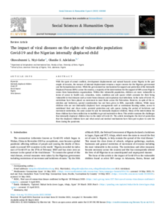With the spate of armed conflicts, development displacements and natural hazards across Nigeria in the past couple of decades, the menace of internal displacement remains a major concern for the Nigerian government and the humanitarian sectors. While the government has mechanisms for support and protection of the Internally Displaced Persons (IDPs) across the country, a majority of the interventions for the support of IDPs across Nigeria comes from humanitarian organizations. Within this vulnerable population, children are more vulnerable in terms of access to health care, education, water, nutrition and safe spaces which accounts for their being vulnerable to viral diseases such as water borne diseases and respiratory tract infections. In the wake of COVID-19, restrictions have been placed on movement in most States across the Federation.
However, in spite of the re- striction and lockdown, special consideration has not been given to IDPs, especially children. While many children who are not (internally) displaced have arrangements such as continuous learning online, access to nutritional food and clean water, parental protection and safe spaces during the period of lockdown and movement restrictions, the same cannot be said for internally displaced children. Many of the interventions for these children have been stalled due to inability to get aid materials to them.
This article examines the challenges that internally displaced children face in the midst of COVID-19. The article investigates the level of protection that the displaced children have and what social and medical mechanisms have been put in place to cater for them during the pandemic.

